Tortillas de Quelites
I hope everyone of you is having a great holiday season and a good New Year! I wish you all profound peace for the upcoming year. I think we can always use a bit more of it.
I should go over the nomenclature of the main extra ingredient for these tortillas. I saw them in Diana Kennedy’s beautiful and massive “Oaxaca al Gusto, an Infinite Gastronomy”, a cookbook dedicated to 11 distinct regions of that southern state in Mexico. This is not the post to get into the book but I’ll just mention it is gorgeous, with many beautiful photos of foods and dishes which can only be found in that region’s remote corners. “Tortillas de Quintonil” which she translates as “Tortillas of Wild Greens” is the recipe I found in the book. In another one of hers, “From My Mexican Kitchen”, she writes that quintoniles include several species from the amaranth family and fall under the umbrella of quelites or wild greens. For Rick Bayless, quelites are more specifically what is known as lamb’s quarters. Marilyn Tausend in “Cocina De La Familia”, also refers to quelites as lamb’s quarters. So you dear readers who are forager’s and/or gardener’s, I include a photo of the green so that you can comment on the identification of it. I appreciate any clarification. In Mexican cooking they are primarily used as a light stew with perhaps onion and garlic, as taco filling, or as an ingredient added to pinto beans. This is the only time I’ve seen them as an ingredient in the masa for corn tortillas. These greens are readily available year round in one of our supermarkets alongside verdolagas, huauzontles, epazote, yerbabueana, berro, other greens or herbs used in Mexican cuisine. We are fortunate to have them. I’m also keeping a good eye out for wild quelites, since they seem to grow wild in many parts of the U.S and Mexico.
According to Kennedy, quelites are used especially during the rainy season to help in times when corn is running low, thus stretching the stock of maize for a longer time. They add a green earthiness to the tortillas which I enjoy. My cilantro flour tortillas came to mind when I made them, but these have a different flavor altogether. They are very tasty and unusual, good for making tacos, quesadillas, or just eaten alone with salsa. They will surely attract curiosity if you present them on your next Mexican buffet.
Kennedy uses fresh corn masa but I opted for masa harina, which means an addition of water is necessary. The quelites provide some moisture so I watched carefully as I added the water. Cooking the greens with a bit of onion and garlic before adding them to the masa makes them more flavorful.
This recipe is an adaptation of hers. She also suggests using other types of edible greens or spinach.
This will make 9 to 10 tortillas:
3 good bunches of quelites ( it will render about 1 cup after cooking down)( each of the bunches weighed about 1/4 #)
about 1 heaping tablespoon chopped onion
2 medium garlic cloves chopped
2 tablespoon oil
1 cup masa harina
1/2 cup water
3/4 teaspoon salt
To be more specific, you need about 6-8 ounces of leaves only. The stems are too tough to use. Remove the leaves from the stems and thoroughy wash them to remove the dirt. Drain them. Get about 2 quarts of slightly salted water to boil in a pot. Add the greens and cook until just tender, about 2-3 minutes. Drain them and run cool water over them. When cool enough to handle, squeeze as much water as you can from them.
Heat a frying or saute pan to medium heat and add the oil, I used grapeseed, but olive oil, vegetable, or other kinds of mild flavored should do ok. Saute the onion for a minute, then add the garlic. Don’t let them burn. Finally add the quelites and fry just lightly for a minute or two. Add more oil if necessary. Remove from the heat and let them cool down. Next, finely chop the green mixture.
In a mixing bowl, put the masa harina, salt, and chopped quelites mixture and blend well together. Add most of the 1/2 cup of water and incorporate. Add more water as needed to make a moist dough. It should be neither too moist or too dry. One way I check is by squeezing a small portion between my thumb and index finger. It should not be too dry that it cracks at the edges.
Divide the masa into 9 or 10 portions and form each into a ball. I let them rest for a few minutes. Keep them covered with a moist towel. They tend to quickly dry out. Get your trusty tortilla press and a piece of plastic wrap. Cut the plastic into two pieces that are each just big enough to cover the plate of your tortilla press.
You might have one of these or the metal type of tortilladora. If not, you can get away with using a rolling pin to shape your tortillas. If you can do it by using your two hands, I’ll be quite impressed.
Get your comal or heavy skillet pre-heated over your stove to medium hotness.
Place one of the pieces of plastic on the plate of the press and put one of the masa balls on top.
Put the other piece of plastic on top. Then press. You may have to rotate the dough once to get a nice circle.
Remove the top plastic
Place the dough and bottom plastic on your weak hand.
Carefully flip it over onto your strong hand and remove the remaining plastic.
It’s ready to flip over onto your hot comal.
The tortilla should give a slight sizzle when you place it on the comal. Cook the tortilla for about a minute to 90 seconds, then flip it over. After another minute or two turn it over again and let it cook maybe another minute. If your tortillas are sticking, they are too moist. If they crack and harden, they are either too dry, or the comal is too hot. You’ll get the hang of getting the dough the right consistency and the skillet to just the right hotness with practice.
When they are done, they may have a few nice brown spots. They should be nice and flexible and not crack when rolled or folded. Keep them covered with a kitchen cloth. So far they’ve kept well after a day when kept in the refrigerator. They just need to be heated up to get their flexibility back.
They tend to be a little thicker than regular corn tortillas, but they are still quite soft and flexible. Just keep them covered.
I made some mouthwatering quesadillas with some of the dough.
Pureed butternut squash flavored with ancho chile powder and epazote for one, and refried beans and epazote for another.
Or the butternut squash and ancho powder puree with cilantro and mild red pepper.
That’s a stripe of New Mexican chile tomato salsa there. Many different types of salsa go well with these.
I know I’m very late but I’m sending these tortillas over to Angie’s Fiesta Friday to help celebrate the 100th edition of her fabulous party where you’ll find insanely talented cooks, gardeners, storytellers, and more presenting their incredible creations. It is quite a feat to have kept it going strong for so long. She also has her many friends who have assisted with the work it takes to keep such a labor of love going. Congratulations Angie!
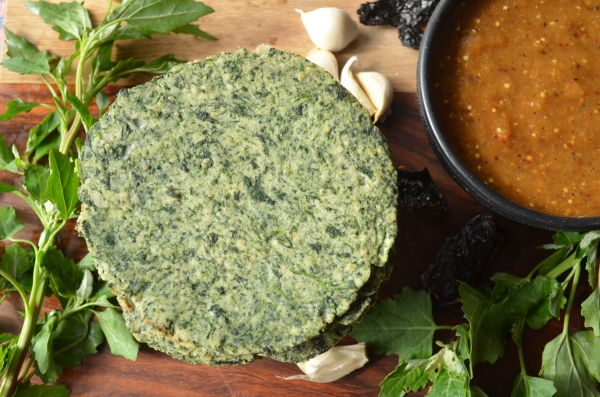

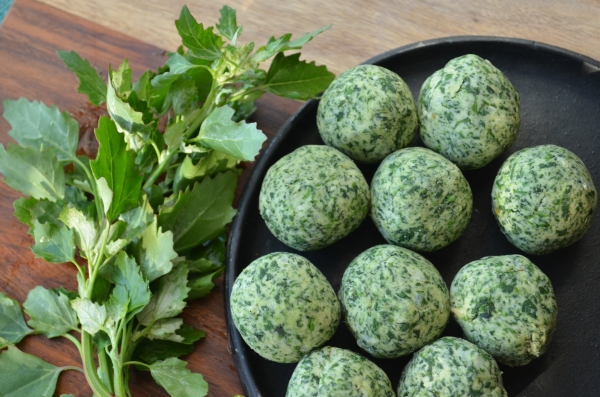



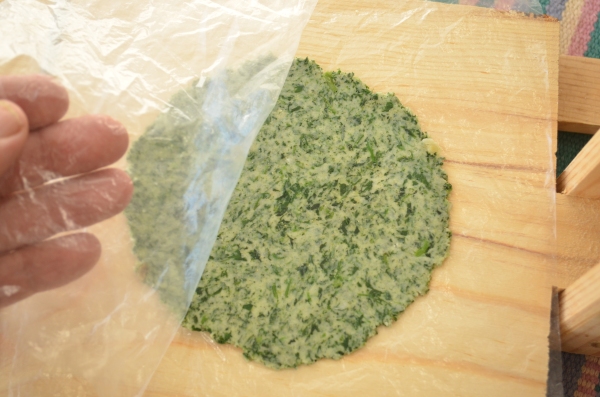
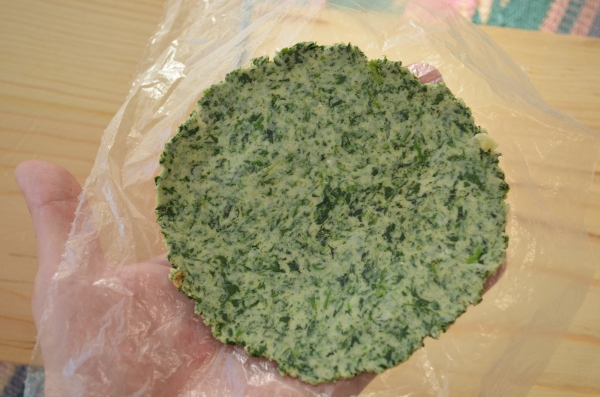
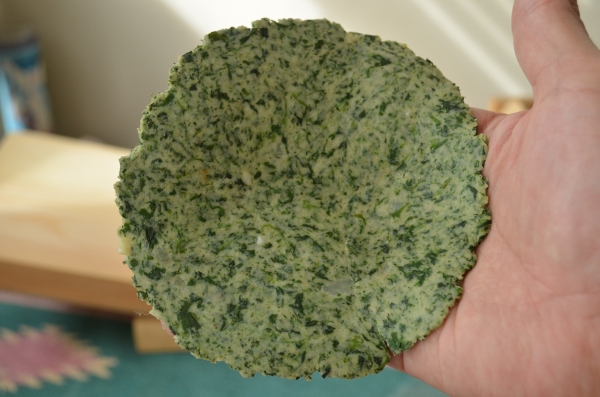

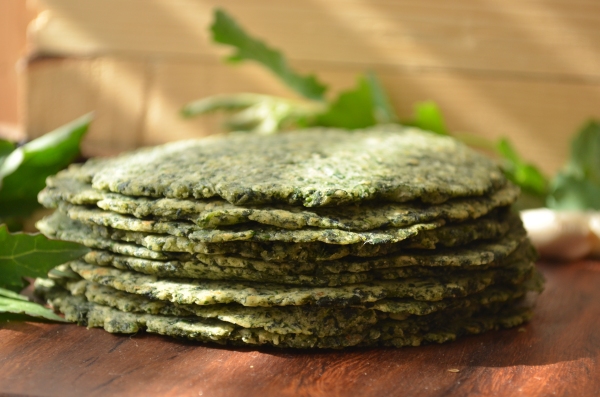
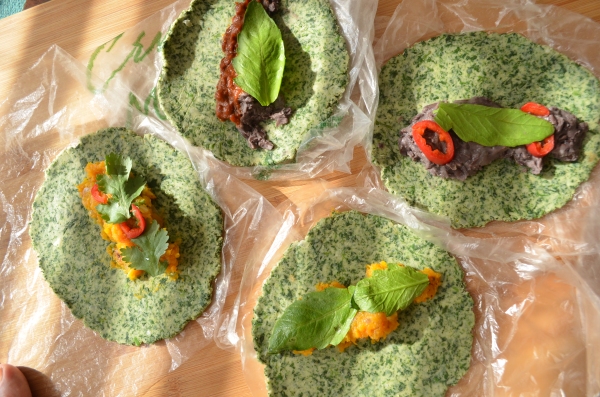

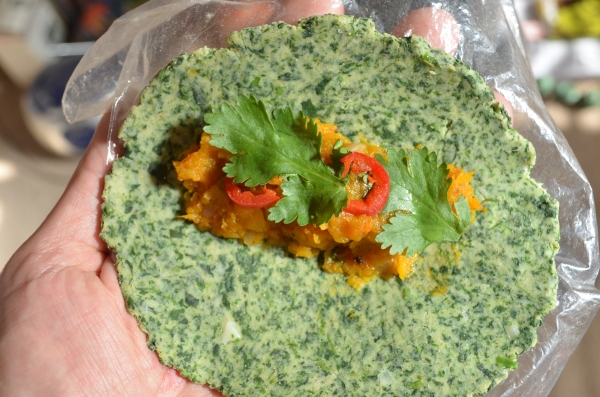
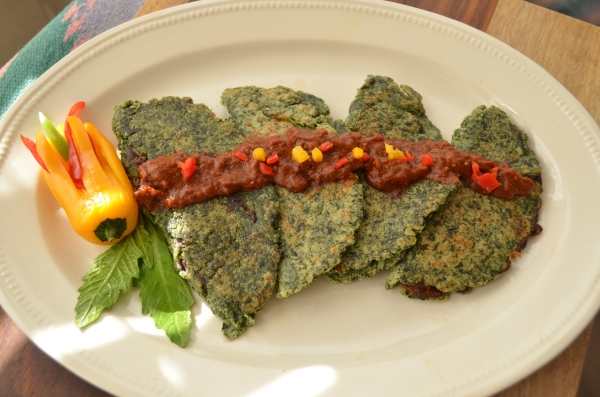
Great post!!! Inspiring! Felix Ano Nuevo!
Thank you very much Robert! Thanks too for your support. Wishing you the best for 2016!
A very enjoyable post. There are many kinds of lambsquarters, but the ones you show are exactly the ones I have in abundance in my garden. This is a great way to use them, and come spring I will certainly be doing so. I’m so glad you brought them along to this week’s Fiesta.
Thank you Hilda! You were one of the ones I thought of who would be able to confirm the identification of the plant. I bet you have any number of wild greens in your area that might work as well. But you know, I was thinking, “Tortillas of Lamb’s Quarter’s” just doesn’t have a good ring to it!
I sure learned a lot reading your post – I love the quesadillas. Thanks for sharing with Fiesta Friday.
Thank you very much for that! I’m glad I was able to share for Fiesta Friday. The quesadillas were very good. Thanks for co-hosting and helping to keep this party going!
OMG Gerard, this reminds me of Saag and Makka ki Roti together in a place. Saag is made with mustard leaves and makka ki Roti is made with corn flour.
The amaranth leaves look like that the picture in your post. In India, it is used in many curries 🙂
Sonal, that’s why Indian flatbreads have always fascinated me. They are so varied and interesting. I recall somewhere about amaranth in India. They seem to be used more in Mexico than the U.S. Thank you for visiting!
😀
So cool, I loved this. The tortillas look delicious and I have never seen the made like that before, so interesting seeing the method of preparation and those quesadilla’s look really wonderful. Thank you so much for sharing this.
Thank you very much Suzanne! I had never seen them made before either. They are really tasty and versatile. Thank you for co-hosting!
What an interesting post! These look amazing and the flavours sound just divine! 😀
Thank you Chef Julianna! They are an excellent alternative to the regular flour or corn tortillas. I think I’ll be making these more often. Thank you for visiting!
Gorgeous and very interesting! I have several of her books, but not that one – might be time to look on Amazon! Thanks for bringing it to Fiesta Friday and I’ll be pinning it to our board, and Happy New Years!
Hi Mollie! Thank you for helping to keep Fiesta Friday going. Yes, I highly recommend her book which has many recipes and much info off the beaten trail.
I appreciate the nice comments!
🙂
They look beautiful – I suppose their greenness makes me dream of Spring … I love your tortilla press, it looks like it can take a punch or two 🙂
Thanks for celebrating with us, Gerard! I came across Bread and Tortillas at a Fiesta Friday I think and have been following your blog ever since.
Here’s to many, many more!
Thank you very much Ginger. I really have been enjoying eating them the past couple of days and now find myself wishing I still had some. I’ll be keeping them “in my repertoire”.
Of course I could not miss Angie’s 100th Fiesta Friday. Thank you for co-hosting yet again!
To many many more indeed!
I hope you are having a great New Year! I’m looking forward to more “Ginger & Bread” in the coming year!
These look so good. I love all of those Mexican herbs and I envy you your tortilla press. I spent 70 days working in Mexico city last year and I’ve had just about all of those herbs and what I wouldn’t do to try these wonderful tortillas! Incredible research and recipe 🙂
Thank you Amanda for the nice comments! I really have been liking these tortillas. I never would have made them if I hadn’t seen them in that cookbook. They are very unusual but delicious. Since adopting a vegan diet I’ve been on the look out for new ways to eat vegetables, fruits and greens.
I’d love to spend some time in Mexico again as it’s been a few years since visiting the interior. As you very well know it’s such a magical place! If only my job would send me on a research trip!
You might look in your local “Hispanic” market or grocery store for the tortilla press. I’ve seen it online as well.
Wishing you a great year ahead!
You are so good at making tortillas! These look fab 🙂
I’ve had some practice on tortilla making Elaine. There is no other way for me. I’ll always be honing my technique. To me, they are just as hard or harder as learning to make bread. My Grandmother could whip out her tortillas like it was second nature to her.
Thanks for visiting! Looking forward to learning more about veggies from you in upcoming year!
Thank you – I’ve more veggies all ready for sharing 🙂
I have to say, when I’ve tried to make tortillas they’ve been tasteless and hard; granted I’ve only tried once, I need to have another go really!
It sure took me more than once to get them acceptable!
That’s good to know!!!
Oh yes, believe that!
I have always wanted to make tortillas from scratch. Actually I have! Why else would I have a 5-lb bag of masa harina in my pantry?! But I didn’t do it well and I didn’t use a tortilla press and didn’t know I could add those wild weeds growing in my backyard. That’s just so cool! I have lambs quarters growing in abundance. Come Spring I’ll be thinking about this, so I’d better save the recipe. Thanks, old friend! 🙂
I immediately figured that you were familiar with these greens and that you had prepared them before. Lucky you probably have all the lamb’s quarters you ever need. I don’t remember seeing much of them wild around here. I certainly never would have thought to put them in corn tortilla dough…Maybe it’s time to for you to get a tortilla press!
The greens remind me of rapini. I love the tortilla press. Did you make it yourself? It doesn’t look hard to make.
Hi Marcella, I sure didn’t make the tortilla press. The great simple design looks like it hasn’t been changed for generations. Now you have me curious about rapini. I’m going to look for it next time I go grocery shopping and try it out. I think they use it a lot in Italian cooking. How do you prepare it?
Yes, rapini is very popular in Italian cooking. I prepare it the way I prepare most greens: rinse them and leave some water on them. Cut off the ends. Cut the stems into 1-2″ pieces. I don’t throw them out, they are edible but I put them on the bottom of the pan to get the most heat and moisture. I put the leaves and flower buds on the top. I drizzle olive oil on top and sprinkle with red pepper flakes. Cover the pan and cook to your desired tenderness. The only thing I do differently with escarole is let the water evaporate completely as I like it to get a bit browned. Not the rapini though. The flower buds are the most tender part and delicious! I add salt at the end. I like them in a sandwich of crusty bread. Since rapini has become so popular, its price has gone up so I started growing it in my garden. I got a small tasting of it this summer and hope to do better next summer. I think you will enjoy it Gerard!
Thanks for the tips Marcella, I’ve been looking out for rapini in the supermarkets but haven’t come across them yet. Maybe they are not in season yet. I’ll keep them on my list though, they do sound like something I’d enjoy. I am always up for a new green or vegetable to try. Stems by the way, are an underrated part of some vegetables in my opinion. Broccoli is one example.
Yes, there is only one store that sells it here: Meijer. Very strange. I grew it myself this summer – it didn’t do too well but at least I got on serving out of it. Ask at your local grocer, that should help!
Wow! What an impressive recipe!
Thanks so much and thank you for visiting and “Liking”. Please come again.
You are most welcome.
Indeed, I plan on visiting your site again, I love it!
I appreciate it. Your sites are very interesting!
🙂 Thank you Gerard. I do hope you enjoy them!
Love this recipe! Happy New year and Happy FF!
I’m glad you like it! Happy New Year and Fiesta Friday to you too!
What a wonderful post! I haven’t seen these ingredients or the press that you used. I’ve made tortilla’s at home but didn’t have a very good recipe because we didn’t care for them.
Thank you Julie! Fresh made tortillas, flour or corn, are worlds away from store bought ones in my opinion. Thank you for visiting!
Happy New Year Gerard! Those lovely greens definitely look like lambs quarters aka goosefoot to me! Do they add a light herby chard/spinachy tasty to the tortillas? I definitely have to give this a go come spring. 🙂
Hi Emily! Thanks for helping to identify them! I saw they can also called be pigweed. Why all the animal references?! They add a bit of a spinach kind of taste but not strong. When I had finished the ones I had made, I went back to using flour tortillas and then wished I had made more of the quelites ones. I really enjoyed their flavor and texture, I’ll be making them again.
Delicious looking Tortillas de Quelites 🙂
Thank you Nandini! Your Tomato Chutney looks great!